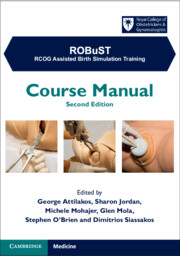Book contents
- ROBuST
- Reviews
- ROBuST
- Copyright page
- Contents
- Contributors
- Preface
- Acknowledgements
- Abbreviations
- Chapter 1 Trends in Assisted Vaginal Birth and Future Practice
- Chapter 2 Indications and Assessment for Assisted Vaginal Birth
- Chapter 3 Non-technical Skills
- Chapter 4 Vacuum-Assisted Birth
- Chapter 5 Non-Rotational forceps and Manual Rotation
- Chapter 6 Rotational Forceps
- Chapter 7 Caesarean Section at Full Cervical Dilatation
- Chapter 8 Medico-Legal Aspects of Assisted Vaginal Birth (AVB)
- Chapter 9 Analgesia and Anaesthesia for Assisted Vaginal Birth
- Index
- References
Chapter 1 - Trends in Assisted Vaginal Birth and Future Practice
Published online by Cambridge University Press: aN Invalid Date NaN
- ROBuST
- Reviews
- ROBuST
- Copyright page
- Contents
- Contributors
- Preface
- Acknowledgements
- Abbreviations
- Chapter 1 Trends in Assisted Vaginal Birth and Future Practice
- Chapter 2 Indications and Assessment for Assisted Vaginal Birth
- Chapter 3 Non-technical Skills
- Chapter 4 Vacuum-Assisted Birth
- Chapter 5 Non-Rotational forceps and Manual Rotation
- Chapter 6 Rotational Forceps
- Chapter 7 Caesarean Section at Full Cervical Dilatation
- Chapter 8 Medico-Legal Aspects of Assisted Vaginal Birth (AVB)
- Chapter 9 Analgesia and Anaesthesia for Assisted Vaginal Birth
- Index
- References
Summary
In skilled hands, assisted vaginal birth (AVB) remains the most efficient and effective method of expediting birth in the second stage of labour. It is associated with fewer adverse maternal and neonatal outcomes compared to second stage emergency caesarean section. In this chapter we will focus on the history and role of AVB as it currently stands. We will review relevant literature, examine important areas of practice and suggest a way forward that aims to maintain AVB at the heart of obstetric practice in the twenty-first century. The need for such focus is clear – complications in the second stage of labour (fetal compromise, obstructed labour, maternal exhaustion, or maternal medical conditions exacerbated by the act of pushing) remain a major cause of maternal and neonatal mortality and morbidity across the world. Such complications are responsible for 4 to 13% of maternal deaths in Africa, Asia, Latin America and the Caribbean. In 2013 obstructed labour alone accounted for 0.4 deaths per 100,000 women worldwide.
- Type
- Chapter
- Information
- ROBuST: RCOG Assisted Birth Simulation TrainingCourse Manual, pp. 1 - 9Publisher: Cambridge University PressPrint publication year: 2024



